Award of Excellence
Vacant Lot Library
Cecil Howell, Student ASLA, College of Environmental Design, UC Berkeley
Faculty Advisor: David Meyer
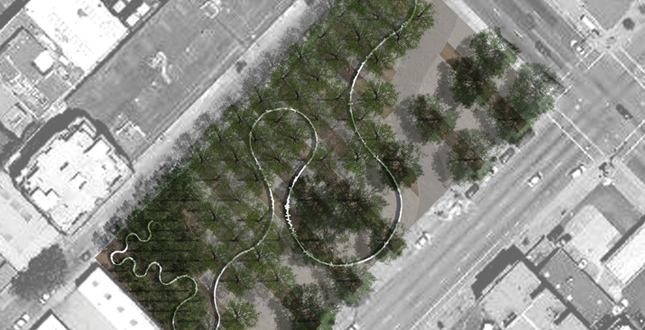
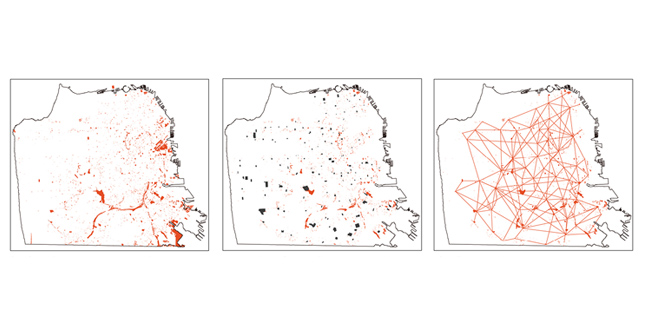 Close Me!
Close Me!City-Scale Diagrams Illustrating the Development of the Mobile Library System. From left to right, Vacant lots in San Francisco; Vacant lots within one-quarter mile of a school; Potential educational network created through the Mobile Library System.
Download Hi-Res ImagePhoto: Cecil Howell
Photo 2 of 15
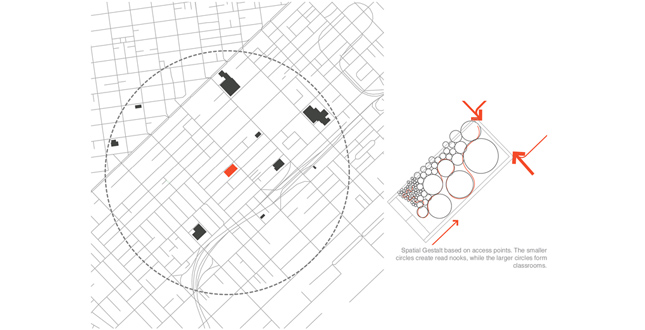 Close Me!
Close Me!Spatial Gestalt based on access points. The smaller circles create read nooks, while the larger circles form classrooms. Location of Schools surrounding 900 Folsom Street.
Download Hi-Res ImagePhoto: Cecil Howell
Photo 3 of 15
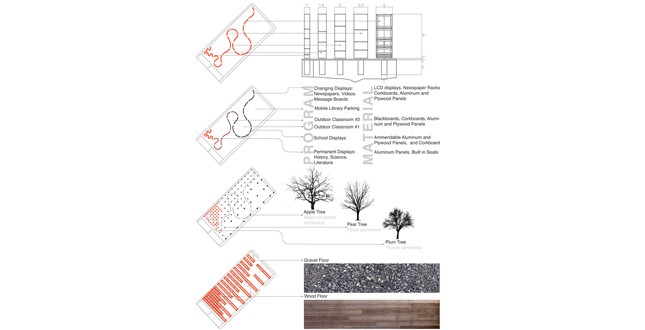 Close Me!
Close Me!Site-Scale Diagrams. From top to bottom, Panel Size widens as the radius of the wall increases; Both program and materials change depending on the type of environment that the wall is creating; Trees grow in height as the space becomes more open; Wood decking and dark gravel interweave in order to create a surface for sitting on.
Download Hi-Res ImagePhoto: Cecil Howell
Photo 4 of 15
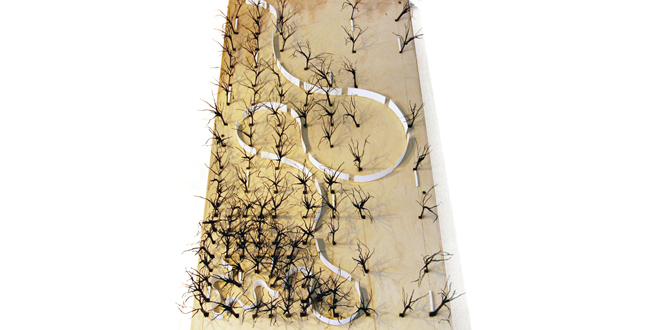 Close Me!
Close Me!Views Wall as it weaves through the site. 1” = 16’ Scale Model.
Download Hi-Res ImagePhoto: Cecil Howell
Photo 5 of 15
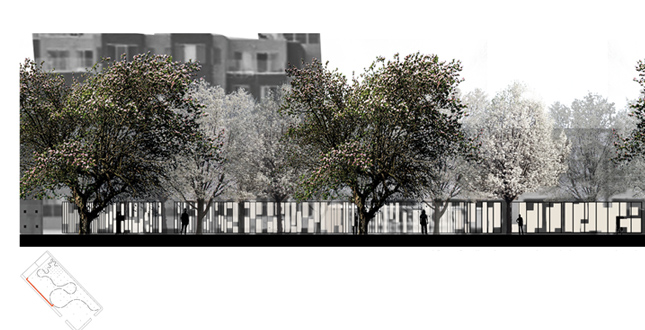 Close Me!
Close Me!View of wall as it weaves through the pear and apple trees.
Download Hi-Res ImagePhoto: Cecil Howell
Photo 6 of 15
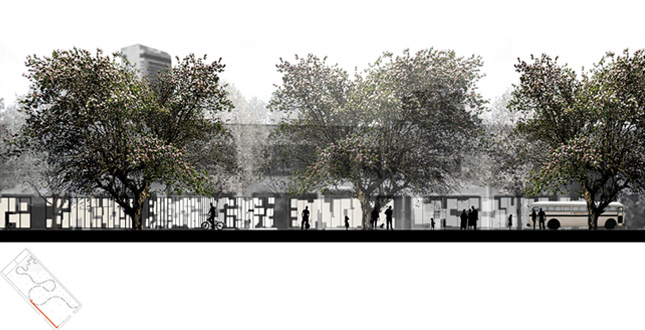 Close Me!
Close Me!View of wall and the mobile library parking area.
Download Hi-Res ImagePhoto: Cecil Howell
Photo 7 of 15
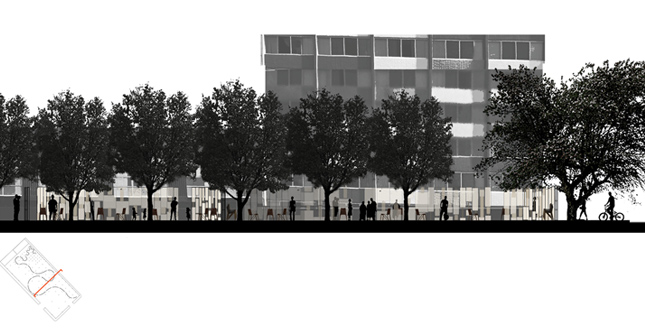 Close Me!
Close Me!View of outdoor classrooms. Site is equipped with portable furniture as well as benches built into the wall and on the wood decking.
Download Hi-Res ImagePhoto: Cecil Howell
Photo 8 of 15
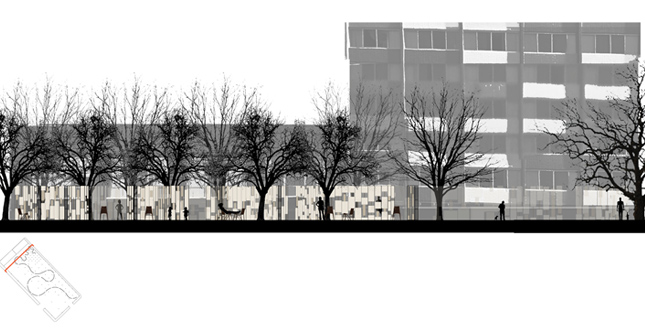 Close Me!
Close Me!View of reading nooks. The smaller plum trees help frame these spaces transforming them into small rooms.
Download Hi-Res ImagePhoto: Cecil Howell
Photo 9 of 15
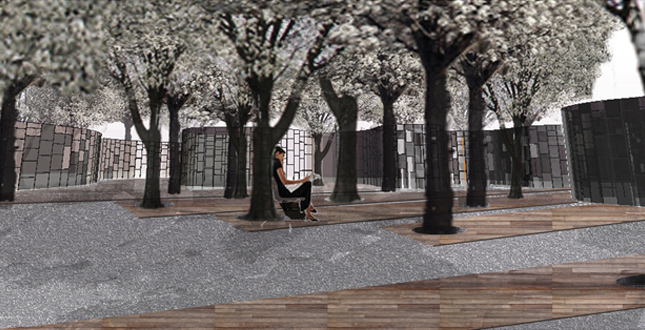 Close Me!
Close Me!Perspective of pear bosque in the springtime.
Download Hi-Res ImagePhoto: Cecil Howell
Photo 10 of 15
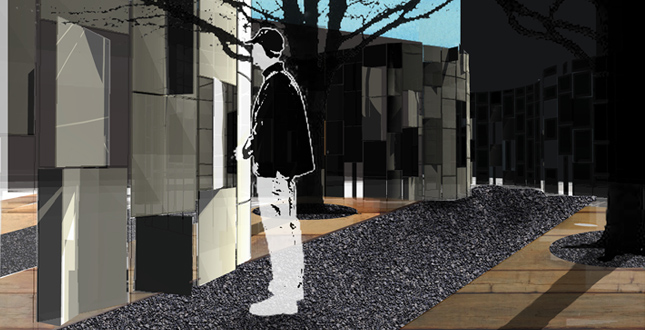 Close Me!
Close Me!Perspective of small reading nook. The wood decking provides a soft surface to sit and lie on, creating an ideal place to read and think.
Download Hi-Res ImagePhoto: Cecil Howell
Photo 11 of 15
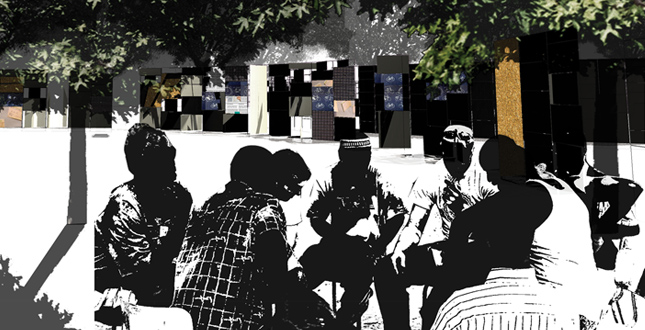 Close Me!
Close Me!Perspective of large outdoor classroom. The wall in this area is made up of aluminum panels, chalkboards, corkboards and other tools for interactive learning.
Download Hi-Res ImagePhoto: Cecil Howell
Photo 12 of 15
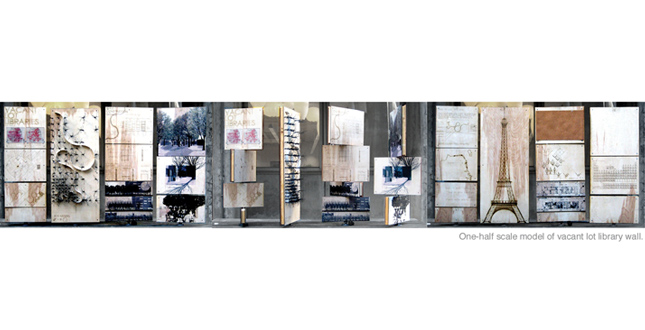 Close Me!
Close Me!One-half scale model of vacant lot library wall.
Download Hi-Res ImagePhoto: Cecil Howell
Photo 13 of 15
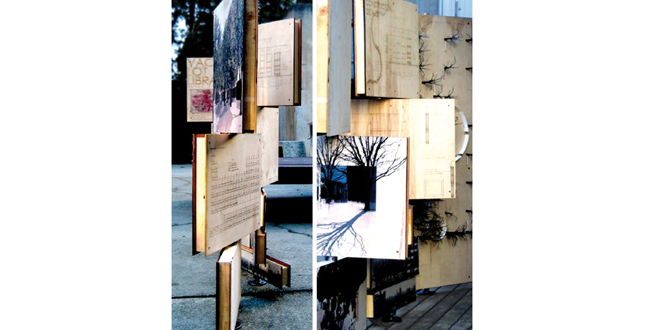 Close Me!
Close Me!One-half scale model of vacant lot library wall.
Download Hi-Res ImagePhoto: Cecil Howell
Photo 14 of 15
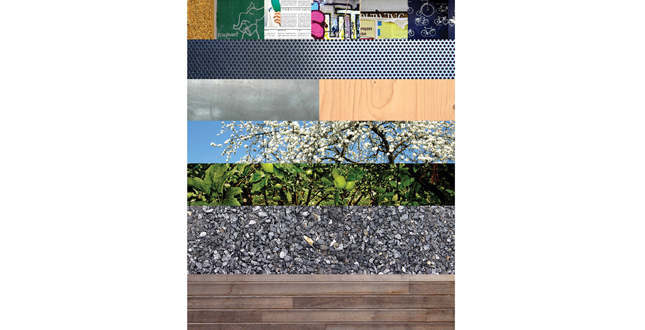 Close Me!
Close Me!Material Palette. Materials incorporated into the site include corkboards, chalkboards, newspaper racks, graffiti walls, message boards, aluminum panels, fruit trees, gravel and wood decking.
Download Hi-Res ImagePhoto: Cecil Howell
Photo 15 of 15
Project Statement
San Francisco is dotted with vacant lots, unused and often forgotten spaces concentrated in the poorest neighborhoods of the city. This project proposes creating a network of outdoor libraries within vacant lots. By converting these spaces into learning landscapes, San Francisco will invest in the knowledge of it’s citizens and transform the forgotten into public spaces that help support creativity, education and community, the foundation for a truly sustainable city.
Project Narrative
Program
At the city-scale, this project proposes a new infrastructure of learning landscapes that is part site and part mobile library. The sites are selected due to their proximity to a school; each site is within one quarter of a mile of a school. While students are not the only users of the vacant lot libraries, they are an important element in maintaining the vitality of each site. The schools are not only visitors to the site but can also help determine the content, either by helping design the site or through displays, projects, and program. A mobile bus provides additional content as well as helps connect the sites together. The bus would not only bring books to the sites, but also science projects, artwork, and essays from other schools to create an exchange of knowledge and ideas throughout the city.
Site
This project explores the design possibilities for one site, a vacant lot located at 5th and Folsom in the South of Market district of San Francisco (SOMA). The area around 5th and Folsom used to be completely industrial, and while there is still some light industry, mostly auto body shops, it is transforming into a more residential neighborhood. Nine schools lie within walking distance to the park, this includes several elementary and nursery schools, a university of law, city college, and a medical college. These institutions are predominantly located to the north and east of the site.
Typical of industrial areas, there is very little public space in the neighborhood, even though there is an influx of residents and there has always been a large population of workers. This site, in addition to becoming a learning landscape, provides the much-needed outdoor space to the workers, customers, residents, and students of the area.
The Wall
The primary design move is an interactive wall which weaves through the site, creating learning spaces as well as providing knowledge. Looking to the library as a source of inspiration, the wall creates both small spaces for private and quiet learning as well as large rooms that can be used as classrooms and activity centers. Since the majority of students will be approaching the site from the southwest, the more active areas are in the southwest corner of the site, while the quieter areas are tucked towards the south end of the site. The wall is eight feet tall and constructed of rotating panels, each panel has information inscribed or mounted on it. By rotating the panels, the user is able to pull information out of the wall as she turns it, a movement inspired by the act of removing a book from a bookshelf. While the higher panels feature information for adults, the lower panels are designed for children and include number, color, and shape games, turning the wall into an enormous puzzle.
Along the wall, the content and material varies, responding to the type of space created. In the southwest corner, the space is divided into small reading rooms. Here, the content is permanent, including displays on the natural and social history of San Francisco,pieces of poetry, and other literature. The panels are constructed from aluminum, with the information etched onto them. The metal supports the permanence of the display as well as reflects light down into the rooms. In several spots panels fold out to become seats, in addition to the benches and moveable chairs that dot the site.
Moving along the wall into the larger spaces, the content becomes more interactive and temporary. Nearby schools, as well as any local businesses or art, science, and tech groups, can take responsibility for a portion of the wall. These rotating exhibitions of work create an opportunity for people to display their knowledge and creativity as well as interact with their neighbors. The wall facilitates strange pairings, such as having an elementary school and a law school adjacent to each other, creating new opportunities for exchange and inspiration. In this area the panels vary in material, from wood to aluminum mesh to cork-board, all of which are designed with clips and other mounting methods in order to facilitate the exhibits.
There are two classrooms on the site, both formed by large sweeping curves of the wall. Within these bulbs, the wall mimics the information found inside a science, history, or mathematics classroom, complete with periodic tables, maps, and formulas. Several panels together form large chalkboards and cork-boards, allowing for easy teaching and amendment. Seating in these areas is primarily moveable chairs, for increased flexibility.
The mobile library enters the site at the north end. This area is very open, in order for the library to have the room to display the books and projects that it carries from school to school. This area is the main plaza of the site and the wall supports this activity hub, by displaying content that varies almost daily, including newspapers, videos, and message boards.
Orchard and Surface
Besides the wall, the site is composed of two other components, a bosque of fruit trees and a changing ground plane. The fruit trees help the site become active, by providing a resource to the community. Within the quieter areas, the trees are planted more densely and are a small variety of plums, creating domes for the reading rooms. Moving out towards the more active areas, the trees become more spread out and larger varieties. The species changes from plum to pear trees and finally apple trees. This helps open the spaces up, while at the same time provides a canopy to create a more comfortable climate.
The ground plane also changes with the gradient of the trees and wall. While the predominant surface material is structural gravel, bands of wood decking interrupt the gravel wherever there are trees. The wood provides a soft surface for lying or sitting on as well as a feeling of warmth to the site. The simplicity of the ground plane, directs the focus towards the wall and the knowledge it contains.
Additional Project Credits





